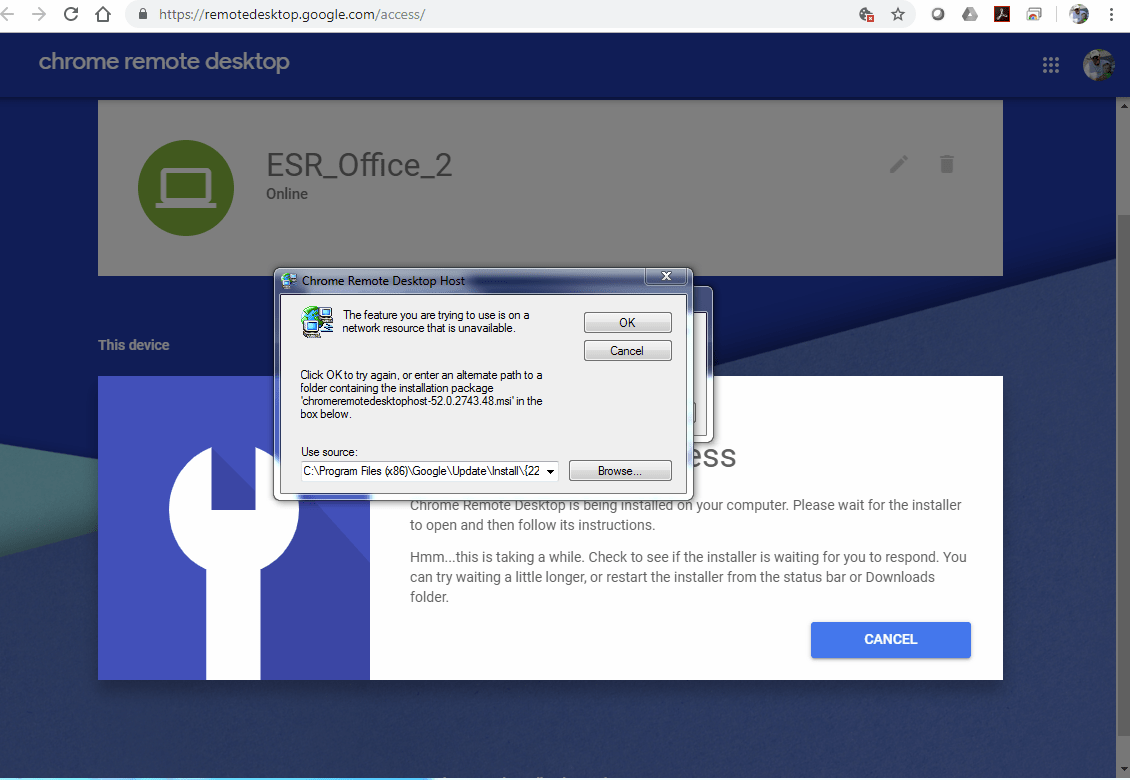

- #CHROME REMOTE DESKTOP FOR MAC HOST HOW TO#
- #CHROME REMOTE DESKTOP FOR MAC HOST FOR WINDOWS 10#
- #CHROME REMOTE DESKTOP FOR MAC HOST FOR ANDROID#
- #CHROME REMOTE DESKTOP FOR MAC HOST DOWNLOAD#
- #CHROME REMOTE DESKTOP FOR MAC HOST WINDOWS#
#2: Disabling ‘Some devices cannot connect without a pin’ Feature Hopefully, this gets you rid of your problem, if not, we still have some ways to get rid of this problem.
#CHROME REMOTE DESKTOP FOR MAC HOST DOWNLOAD#
Now all you have to do is download the Google Chrome again.Open it and delete the folder named ‘ Chrome’.
#CHROME REMOTE DESKTOP FOR MAC HOST WINDOWS#
Press Windows + R and type ‘ %appdata%’. Right Click at the bottom left corner of the screen. In order to do this, follow the steps given here: Mac: Set RemoteAccessHostMatchUsername to YES in ~/Library/Preferences/.There is a fair chance that uninstalling Chrome might get this issue fixed. To require users to register their machines for remote access using a Google Account that matches their local machine account, set the RemoteAccessHostMatchUsername policy on Mac ® Linux ® and Chrome devices. Sudo defaults delete RemoteAccessHostRequireCurtainĮnable Account Name Matching for Chrome Remote Desktop To restore RemoteAccessHostRequireCurtain, delete the key from the defaults for the current user and root:ĭefaults delete RemoteAccessHostRequireCurtain Sudo defaults write RemoteAccessHostRequireCurtain -boolean true Set the default value of RemoteAccessHostRequireCurtain to true using the defaults command for both the current user and root:ĭefaults write RemoteAccessHostRequireCurtain -boolean true Reg add HKLM\Software\Policies\Google\Chrome /v RemoteAccessHostRequireCurtain /d 1 /t REG_DWORD /f & reg add "HKLM\SYSTEM\CurrentControlSet\Control\Terminal Server" /v fDenyTSConnections /d 0 /t REG_DWORD /f & reg add "HKLM\SYSTEM\CurrentControlSet\Control\Terminal Server\WinStations\RDP-Tcp" /v SecurityLayer /d 1 /t REG_DWORD /f & reg add "HKLM\SYSTEM\CurrentControlSet\Control\Terminal Server\WinStations\RDP-Tcp" /v UserAuthentication /d 0 /t REG_DWORD /f & net stop chromoting & net start chromotingįor more information on these keys and values, see Configure Server Authentication and Encryption Levels. You can also copy and run the following command from an elevated command line to set the required registry key values and force them to take effect: 
Make sure you have completed all the steps above. Important: If your session terminates immediately, you may have missed a step.
HKEY_LOCAL_MACHINE\SYSTEM\CurrentControlSet\Control\Terminal Server\WinStations\RDP-Tcp\SecurityLayer to 1. #CHROME REMOTE DESKTOP FOR MAC HOST FOR WINDOWS 10#
HKEY_LOCAL_MACHINE\SYSTEM\CurrentControlSet\Control\Terminal Server\WinStations\RDP-Tcp\UserAuthentication to 0.Īdditional registry key for Windows 10 installations:. HKEY_LOCAL_MACHINE\SYSTEM\CurrentControlSet\Control\Terminal Server\fDenyTSConnections to 0. HKEY_LOCAL_MACHINE\Software\Policies\Google\Chrome\RemoteAccessHostRequireCurtain to 1. Note: This feature only works on Windows devices running Windows Professional, Ultimate, Enterprise, or Server. For more information about Curtain mode, see Access another computer with Chrome Remote Desktop. You can enable Chrome Remote Desktop to prevent someone physically present at a host machine from seeing what a user is doing when remotely connected. Enable Curtain mode for Chrome Remote Desktop Though not necessary if the API is blocked, you can also block to prevent the web client from being loaded. All three use the same service API so blocking it will prevent all Chrome Remote Desktop functionality on your network.īlocking prevents all Chrome Remote Desktop functionality for both outgoing connections from clients on your network and incoming connections to hosts on your network. #CHROME REMOTE DESKTOP FOR MAC HOST FOR ANDROID#
To prevent users on your network from remotely accessing other computers or to prevent computers on your network from being remotely accessed with Chrome Remote Desktop, block the appropriate Chrome Remote Desktop URLs.Ĭhrome Remote Desktop clients include a website ( ) and mobile apps for Android and iOS.
#CHROME REMOTE DESKTOP FOR MAC HOST HOW TO#
Linux: Set RemoteAccessHostFirewallTraversal to FALSE in /etc/opt/chrome/policies/managed/RemoteAccessHostFirewallTraversal.json.įor details on how to define policy settings for Linux, see Set policies Block Chrome Remote Desktop functionality. Mac: Set RemoteAccessHostFirewallTraversal to NO in ~/Library/Preferences/. Windows: Set HKEY_LOCAL_MACHINE\Software\Policies\Google\Chrome\RemoteAccessHostFirewallTraversal to 0. To enable Chrome Remote Desktop for local area network or VPN users only, disable firewall traversal by setting the RemoteAccessHostFirewallTraversal policy on Windows ® Mac ® and Linux ® machines. Control Chrome Remote Desktop network settings The "1" and "0" values are of type DWORD-32. Note: The parent registry keys you use to control the use of Chrome Remote Desktop may not exist even with Chrome installed. As an administrator, you can control whether users can access other computers from Chrome using Chrome Remote Desktop.






 0 kommentar(er)
0 kommentar(er)
